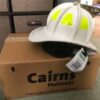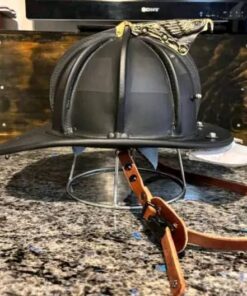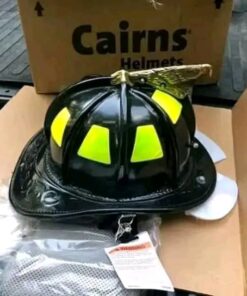2024 New Yorker N5A Cairns Leather Helmet
$800.00 – $1,300.00Price range: $800.00 through $1,300.00
Fire Chief Helmet Specifications
-
Helmet Shell
-
Material: Fiberglass, reinforced thermoplastic, or composite materials
-
Heat Resistance: Withstands high temperatures up to 500°F (260°C) or more
-
Impact Resistance: Meets NFPA 1971 or equivalent safety standards
-
-
Inner Liner / Suspension System
-
Material: Shock-absorbing foam or padding
-
Adjustability: Multi-point suspension system for secure fit
-
Comfort: Moisture-wicking and removable liners for easy cleaning
-
-
Front Shield / Badge Holder
-
Material: Durable plastic or metal
-
Customization: Displays Fire Chief rank, department name, and insignia
-
-
Face Shield / Visor
-
Type: Clear, tinted, or heat-resistant visor
-
Protection: Shields eyes and face from heat, debris, and smoke
-
-
Neck and Ear Protection
-
Design: Extended rear brim or flap to protect neck
-
Ear Coverage: Side flaps for partial ear protection without blocking hearing
-
-
Straps and Buckles
-
Material: High-strength nylon or leather
-
Chin Strap: Adjustable, quick-release buckle for safety and convenience
-
-
Weight
-
Typical Range: 2.5 – 4 lbs (1.1 – 1.8 kg), depending on material and accessories
-
-
Color and Visibility
-
Primary Color: Usually red for Fire Chief
-
Reflective Markings: Enhances visibility in low-light or smoky environments
-
-
Accessory Compatibility
-
Can accommodate lights, cameras, communication devices, and face shields
-
Fire Chief Helmet
The Fire Chief Helmet is a high-quality, durable helmet designed for fire chiefs and senior firefighters. It provides maximum protection during firefighting and emergency operations. Made from strong, heat-resistant materials, it helps protect against heat, impact, and falling debris. The helmet often features a front shield or badge area, adjustable straps for a secure fit, and a comfortable inner lining for long hours of wear. Its classic design makes it easy to identify the fire chief on the scene, ensuring leadership and safety in emergencies.
Our Fire Chief Helmet offers top-notch protection and comfort for fire chiefs and senior firefighters. Made from heat-resistant, impact-resistant materials, it keeps you safe during emergency operations. The adjustable fit, cushioned interior, and classic front shield make it both practical and iconic, helping fire chiefs stand out on the scene.
The Fire Chief Helmet is more than just protective gear — it’s a symbol of authority, courage, and leadership in the fire service. Whether you’re a professional firefighter, a collector, or seeking a high-quality helmet for ceremonial purposes, the right Fire Chief Helmet offers unmatched safety, comfort, and style.
Key Features of a Fire Chief Helmet
-
Durable Outer Shell
-
Made from high-quality materials like fiberglass, thermoplastic, or reinforced composite.
-
Designed to withstand extreme heat, impact, and falling debris.
-
-
Protective Inner Liner
-
Comfortable padding to absorb shocks and reduce head injuries.
-
Often adjustable to fit different head sizes securely.
-
-
Front Shield/Badge Holder
-
Prominent shield for displaying rank (Fire Chief) and department insignia.
-
Usually removable or customizable.
-
-
Heat-Resistant Face Shield or Visor
-
Optional clear or tinted visor for eye protection against smoke, debris, and heat.
-
-
Neck and Ear Protection
-
Extended rear brim or flap to protect the neck from falling sparks or water.
-
Side flaps for ear protection without compromising hearing.
-
-
Comfort Features
-
Sweatbands and moisture-wicking liners for long-term wear.
-
Ventilation channels to allow airflow while maintaining safety.
-
-
Accessory Compatibility
-
Mounts for lights, cameras, or communication devices.
-
-
Distinctive Design
-
Bright colors (often red for chiefs) for high visibility.
-
Unique shape to distinguish the Fire Chief from other personnel on the scene.
Why Firefighters Choose the Fire Chief Helmet
-
Maximum Protection
-
Fire Chief Helmets are built with high-quality materials to withstand extreme heat, falling debris, and impacts.
-
The inner liner absorbs shocks and reduces the risk of head injuries during dangerous firefighting situations.
-
-
Rank Identification
-
The distinctive design, often with a front shield or badge, clearly identifies the wearer as a Fire Chief.
-
This ensures effective leadership and quick decision-making on the fireground.
-
-
Comfort and Fit
-
Adjustable interior padding and sweatbands allow for a secure, comfortable fit during long shifts.
-
Ventilation features reduce heat buildup, keeping firefighters more comfortable under extreme conditions.
-
-
Enhanced Visibility
-
Bright colors and reflective markings help team members locate the Fire Chief quickly in smoky or dark environments.
-
-
Accessory Compatibility
-
Fire Chief Helmets often allow attachments like lights, cameras, or communication devices, improving functionality during emergency operations.
-
-
Durability and Longevity
-
Made to withstand harsh conditions over many years, reducing the need for frequent replacements.
-
-
Tradition and Prestige
-
Wearing a Fire Chief Helmet symbolizes leadership, experience, and respect within the firefighting community.
History of the Fire Chief Helmet
-
Early Origins
-
The first firefighting helmets appeared in the early 19th century, made primarily of leather.
-
These helmets were designed to protect firefighters from falling debris and hot embers during fires.
-
-
Introduction of Rank Distinction
-
As fire departments grew, helmets started to indicate rank.
-
The Fire Chief’s helmet was often more ornate or brightly colored (commonly red) to distinguish the leader on the scene.
-
-
Evolution of Materials
-
Early helmets were made from leather, which offered flexibility and moderate protection.
-
Over time, materials like fiberglass and reinforced thermoplastics were introduced, providing better heat resistance, durability, and lighter weight.
-
-
Design Enhancements
-
Modern Fire Chief Helmets feature extended brims, shock-absorbing liners, and face shields.
-
Ventilation, sweatbands, and adjustable interior fittings were added to improve comfort and usability during long shifts.
-
-
Symbol of Leadership and Tradition
-
The Fire Chief Helmet has become an iconic symbol of authority and respect in firefighting.
-
Many departments maintain traditional helmet designs while incorporating modern safety technology.
-
-
Global Influence
-
While designs vary worldwide, the concept of a specially designated helmet for the fire chief is common across most professional fire services.
Caring for Your Fire Chief Helmet
-
Regular Cleaning
-
Wipe the helmet’s exterior with a soft, damp cloth to remove dust, soot, and debris.
-
For tougher stains, use mild soap and water—avoid harsh chemicals that could weaken the helmet material.
-
-
Inspect for Damage
-
Check the helmet regularly for cracks, dents, or loose components.
-
Ensure the chin strap, suspension system, and face shield are secure and functioning properly.
-
-
Protect the Interior
-
Remove and clean the liner or padding according to the manufacturer’s instructions.
-
Allow liners to air dry completely before reassembling.
-
-
Avoid Extreme Conditions
-
Do not leave the helmet in direct sunlight for extended periods, as UV rays can degrade materials.
-
Avoid storing near strong chemicals or solvents that may damage the helmet.
-
-
Proper Storage
-
Store the helmet in a cool, dry place.
-
Use a helmet bag or dedicated shelf to prevent scratches or accidental impacts.
-
-
Regular Replacement of Components
-
Replace worn-out straps, liners, or face shields promptly to maintain maximum protection.
-
Follow the manufacturer’s recommended replacement schedule to ensure safety compliance.
-
-
Maintain Reflective Surfaces
-
Keep reflective stickers and badges clean and intact for high visibility during emergency operations.
Fire Chief Helmet FAQ
1. What makes a Fire Chief Helmet different from a regular firefighter helmet?
-
The Fire Chief Helmet is designed to indicate rank, typically featuring a distinctive color (often red) and a front shield displaying the Fire Chief insignia. It also includes enhanced features like better padding, face shields, and accessory compatibility.
2. What materials are Fire Chief Helmets made of?
-
Modern Fire Chief Helmets are made from durable materials like fiberglass, reinforced thermoplastics, or composite materials. Early versions were traditionally made of leather.
3. How should I clean my Fire Chief Helmet?
-
Use a soft, damp cloth for daily cleaning. For tougher stains, mild soap and water can be used. Avoid harsh chemicals that may damage the helmet’s materials.
4. How do I ensure my helmet fits properly?
-
Most helmets come with adjustable interior liners and suspension systems. Make sure the helmet sits snugly on your head without being too tight, and the chin strap is secure.
5. How long does a Fire Chief Helmet last?
-
With proper care, modern helmets can last many years. However, components like liners, straps, and face shields may need periodic replacement. Always follow the manufacturer’s recommendations.
6. Can I attach accessories to my Fire Chief Helmet?
-
Yes, many helmets allow attachments such as lights, cameras, and communication devices to improve functionality during firefighting operations.
7. Why is visibility important for a Fire Chief Helmet?
-
Bright colors and reflective markings help team members quickly identify the Fire Chief in smoky or dark environments, ensuring clear command and control during emergencies.
8. Are Fire Chief Helmets standardized?
-
While designs may vary between departments, helmets must meet safety standards for impact, heat resistance, and durability. Some departments maintain traditional designs for ceremonial or historical purposes.
-
-
-
-
-
-
-
-
| Options | Band New Medium size, Brand New Large size, Refurbished Medium size, Refurbished Large size |
|---|
Be the first to review “2024 New Yorker N5A Cairns Leather Helmet” Cancel reply
Related products
N5A Leather Helmet
N5A Leather Helmet
N5A Leather Helmet
N5A Leather Helmet
N5A Leather Helmet
N5A Leather Helmet
N5A Leather Helmet
N5A Leather Helmet






















Reviews
There are no reviews yet.